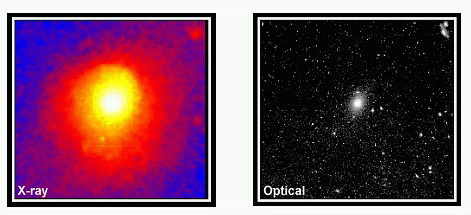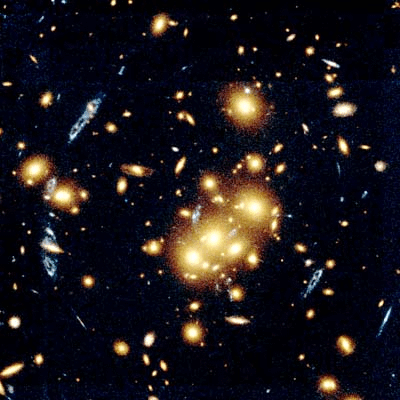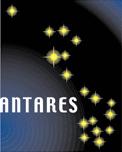Galaxies almost
always come in groups of a few (such as the Local Group) to as many
as a few thousand (e.g. the Virgo cluster). These mass concentrations
thus contain tracer particles (the galaxies themselves) which can be
used to reconstruct the mass distribution of the total system). A dark
matter problem emerges in these studies which is even more serious than
the one for the Galaxy (i.e. individual galaxies) mentioned above. This
ROSAT image (right) of the Virgo cluster of galaxies reveals a hot X-ray
emitting plasma or gas with a temperature of 10-100 million degrees pervading
the cluster. False colors have been used to represent the intensity of
X-ray emission. The large area of X-ray emission, just below and left of
center, is about 1 million light-years across. The giant elliptical galaxy
M87(see optical image), the biggest member of the cluster, is centered in
that area while other cluster members are scattered around it. By adding
up the amount of X-ray emitting gas astronomers have found that its total
mass is up to 5 times the total mass of the cluster galaxies themselves
- yet all this matter still does not produce nearly enough gravity to keep
the cluster from flying apart! What is the unseen mass?
Einstein showed that massive
objects can bend the path of lightbeams, and if they are
compact enough focus the light like a lens does in a telescope. The
image shows how distant (background galaxies) have been magnified and
distorted by the matter distribution in a foreground cluster of galaxies.
The foreground galaxies are mostly yellow, and the background ones blueish.
Studies of images like this show
that there is a lot more matter in this cluster of galaxies than just
that in the visible galaxies and gas.
|

X-ray and Optical
images of the galaxy cluster in the constellation Virgo. The optical
image shows the visible galaxies in the cluster (right), while the X-ray
image displays the hot gas which resides between the galaxies (left).
Source : GSFC

Lensed galaxies appear
blue in this image of a nearby cluster. The yellow galaxies are the ones
acting as the lenses.
Source : HST
|


